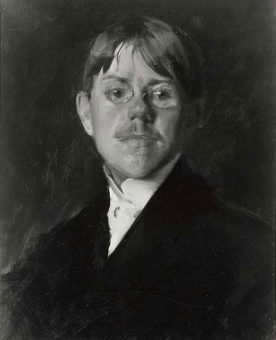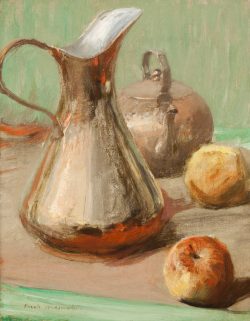William Merritt Chase, Frank Russell Wadsworth, oil on canvas (20 by 16 inches), collection of Remak Ramsay, New York.

Frank R. Wadsworth 1871–1905
Francis (Frank) Russell Wadsworth was born in Chicago, the only son of a distinguished physician and his artistically inclined wife. Wadsworth apparently demonstrated an early interest in art, and he briefly attended the Art Institute of Chicago as a youth. He probably also received some private training, for when he returned to the Art Institute in 1895 he sped through much of the curriculum in only eleven months and earned several honorable mentions. The same year, one of his works was accepted for the museum’s annual exhibition of watercolors and pastels. In 1896 Wadsworth and his widowed mother, who became his constant traveling companion, visited Madrid to view the Prado’s renowned collection. It was probably in Spain that they met the famous American artist William Merritt Chase, who would become the young man’s teacher, mentor, and friend. Returning to Chicago, Wadsworth resumed his studies at the Art Institute and showed his watercolors in his hometown and at the Tennessee Centennial Exposition in Nashville.
Seeking to refine his skills in oil painting Wadsworth went to New York City in 1897 to study under Chase at the newly established Chase School of Art (later the New York School of Art). He also spent summers at Chase’s private school of outdoor painting at Shinnecock on Long Island. While continuing to participate in the Art Institute’s annual exhibitions of watercolors and pastels, Wadsworth made his debut as an oil painter in the 1898 exhibition of New York’s Society of American Artists. From his mentor, Wadsworth absorbed a modern approach to painting that featured bravura brushwork, unconventional perspectives and compositions, and contemporary subjects. When he resumed exhibiting in 1902 after a three-year hiatus, his paintings were controversial for their formal qualities and their conspicuous lack of what critics called “poetry.” Primarily a landscapist, Wadsworth also painted several images of figures in interiors.
In 1903 Wadsworth worked with Chase in picturesque Bristol, Pennsylvania, and he traveled with him to Holland to attend his summer painting class in Haarlem. Chicago critics took note of the young artist’s striking plein-air paintings, one of which received the prestigious Young Fortnightly Prize in 1904. That year, Wadsworth was also recognized with a bronze medal at the Louisiana Purchase Exposition in St. Louis, and he exhibited his work in several major national shows while serving on the jury for the Art Institute’s American art annual. The Chicago Academy of Fine Arts (founded in 1902) mounted a solo show for him in February 1905. The following summer, Wadsworth once again accompanied Chase to Spain, on what was to be his last trip. The unexpected death of the barely thirty-year-old artist shocked the Chicago art community, where Wadsworth was noted as one of the city’s most promising talents. The Art Institute’s 1906 Chicago artists’ annual included a memorial display of eighteen works by Wadsworth who, according to the Chicago Chronicle, had given “promise of a brilliant future.”i
Wendy Greenhouse, PhD
i “Francis R. Wadsworth,” Chicago Chronicle, Nov. 19, 1905.
